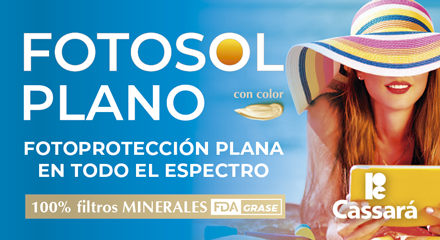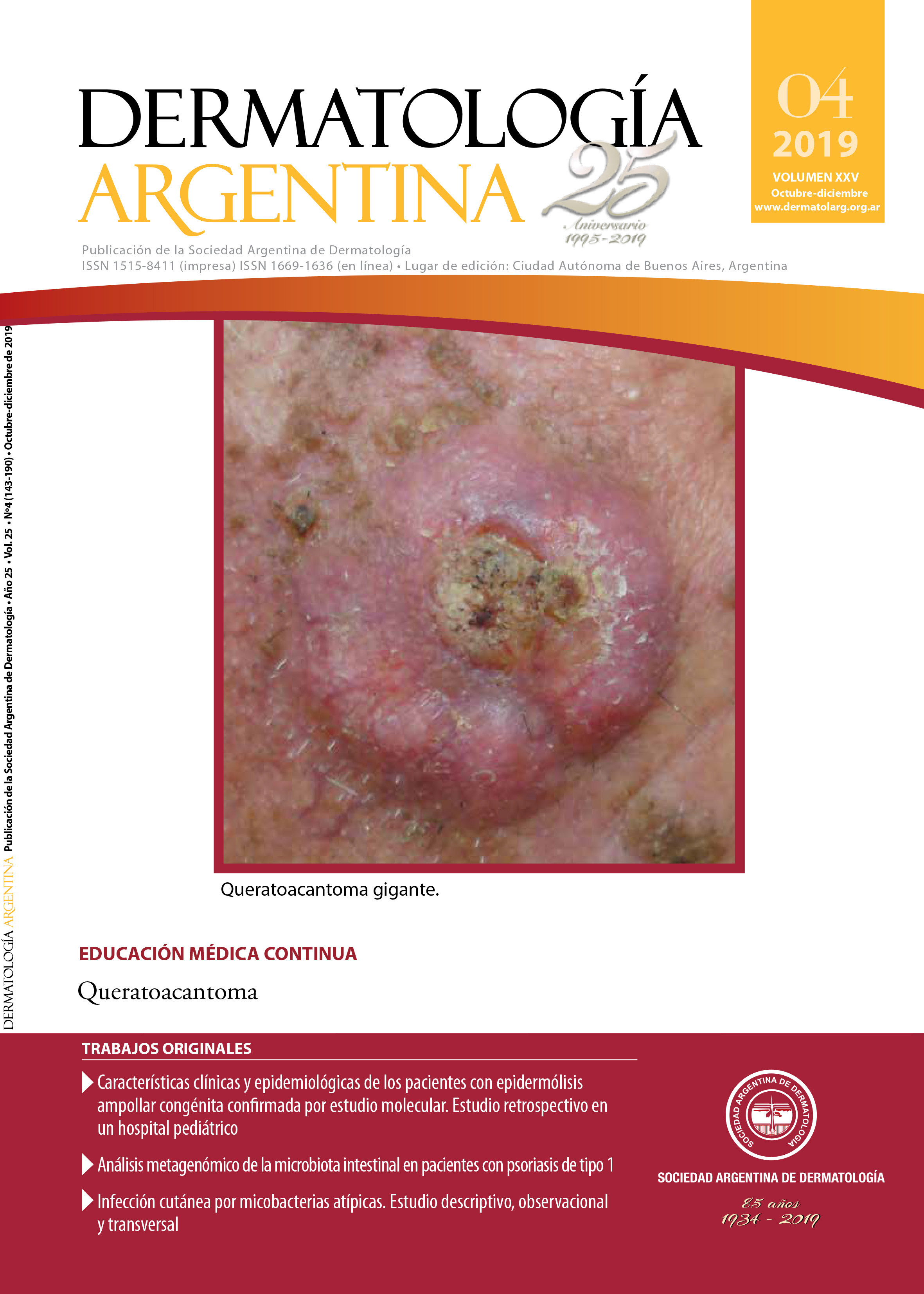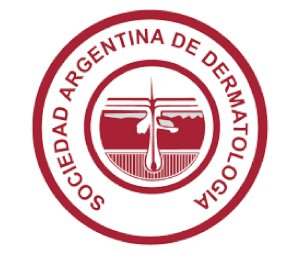Keratoacanthoma
Keywords:
keratoacanthoma, squamous cell carcinoma, CD105, CD34, p53, Ki67Abstract
Alcalá et ál. keratoacanthoma is defined as “a common keratinizing cutaneous squamous neoplasia, characterized by rapid and abundant growth, followed by spontaneous involution, whose classic appearance is in the skin exposed to the sun by elderly, light-skinned individuals”.
This medical education aims to review the pathology, with its different clinical forms, classification, diagnosis, treatments and update the concept, always controversial, of whether it is an entity other than epidermoid carcinoma, based on the latest studies in biology molecular.
References
I. Alcalá D, Gutiérrez R, Gutiérrez RM, Medina A, et ál. Queratoacantoma. Comunicación de un caso. Rev Cent Dermatol Pascua 2003;12:126-130.
II. Schwartz RA. Keratoacanthoma. J Am Acad Dermatol 1994;30:1-19.
III. Mandrell JC, Santa Cruz D. Keratoacanthoma: hyperplasia, benign neoplasm, or a type of squamous cell carcinoma? Semin Diagn Pathol 2009;26:150-163.
IV. Ferreyra de Prato R, Talavera AD, Panico RL, Kiguen X, et ál. Queratoacantoma oral. Revisión de la literatura y comunicación de un caso. Rev Fac Ciencias Médicas Universidad Nacional de Córdoba 2009;66:21-25.
V. Ghadially FN, Barton BW, Kerridge DF. The etiology of keratoacanthoma. Cancer 1963;16: 603-611.
VI. Hsi ED, Svoboda-Newman SM, Stern RA, Nickoloff BJ, et ál. Detection of human papillomavirus DNA in keratoacanthomas by polymerase chain reaction. Am J Dermatopathol 1997;19:10-15.
VII. Miot HA, Miot LD, da Costa AL, Matsuo CY, et ál. Association between solitary keratoacanthoma and cigarette smoking: a case-control study. Dermatol Online J 2006;12:2.
VIII. De Hertog SA, Wensveen CA, Bastiaens MT, Kielich CJ, et ál. Relation between smoking and skin cancer. J Clin Oncol 2001;19:231-238.
IX. Goldberg LH, Silapunt S, Beyrau KK, Peterson SR, et ál. Keratoacanthoma as a postoperative complication of skin cancer excision. J Am Acad Dermatol 2004;50:753-758.
X. Azaz B, Lustmann J. Keratoacanthoma of the lower lip. Review of the literature and report of a case. Oral Surg Oral Med Oral Pathol 1974;38:918-927.
XI. Poleksic S. Keratoacanthoma and multiple carcinomas. Br J Dermatol 1974;91:461-463.
XII. Moffatt JL, Rook A. Multiple self-healing epithelioma of Ferguson Smith type; report of a case of unilateral distribution. AMA Arch Derm 1956;74:525-532.
XIII. Rossman RE, Freeman RG, Knox JM. Multiple keratoacanthomas. A case study of the eruptive type with observations on pathogenesis. Arch Dermatol 1964;89:374-381.
XIV. Clausen OP, Beigi M, Bolund L, Kølvraa S, et ál. Keratoacanthomas frequently show chromosomal aberrations as assessed by comparative genomic hybridization. J Invest Dermatol 2002;119:1367-1372.
XV. Cheville JC, Bromley C, Argenyi ZB. Trisomy 7 in keratoacanthoma and squamous cell carcinoma detected by fluorescence in-situ hybridization. J Cutan Pathol 1995;22:546-550.
XVI. Watanabe IC, Magalhães RF, de Moraes AM, Stelini RF, et ál. Keratoacanthoma and keratoacanthoma like squamous cell carcinoma.Medicine (Baltimore) 2015;94:1-6.
XVII. Saavedra T, Espinoza M, Hojman L, Carreño L, et ál. Queratoacantoma: Presentación como cuerno cutáneo Rev Chilena Dermatol 2010;26:427-434.
XVIII. Villanueva Ramos TI, Alcalá Pérez D, Medina Bojórquez A, Torres González S, et ál. Queratoacantoma: ¿Pseudocáncer o carcinoma epidermoide? Dermatol Rev Mex 2012;56:26-29.
XIX. Har Machado H, Menna Alves A, Neutzling Gomes AP, Torriani MA. Keratoacanthoma in the cutaneous area of the upper lip: a case report. Rev Odonto Ciênc 2012;27:242-245.
XX. Gleich T, Chiticariu E, Huber M, Hohl D. Keratoacanthoma: a distinct entity? Exp Dermatol 2016;25:85-91.
XXI. Feinsilber DG, Reggio SA. Queratoacantoma gigante. Rev Argent Dermatol 1987;68:47-54.
XXII. Rani N, Kumar P, Patil JD, Choudhary SS. Keratoacanthoma centrifugam marginatum: an atypical presentation. J Postgrad Med 2013;59:58-60.
XXIII. Giglio P, Bravo F, del Solar M, Salomon M, et ál. Queratoacantoma centrifugum marginatum: reporte de caso. Folia dermatol Peru 2010;21:91-94.
XXIV. El-Khayat RH, McGrath C, Walsh MY, Ferguson M, et ál. Spontaneous resolution of keratoacanthoma centrifugum marginatum. Clin Exp Dermatol 2014;39:854-856.
XXV. Dogra S, Vinay K, Saikia UN, De D, et ál. Multiple keratoacanthoma centrifugum marginatum in a young boy, and review of the literature. Clin Exp Dermatol 2017;42:711-713.
XXVI. Feinsilber D, Pacheco E, Cha D, Kogan N, et ál. Queratoacantoma: complicaciones óseas. Med Cut ILA 1991;19:307-311.
XXVII. Ruiz de Casas A, Camacho F. Queratoacantoma subungueal. Piel 2005;20:290-292.
XXVIII. Nofal A, Assaf M, Nofal E, Alradi M. Generalized eruptive keratoacanthoma: proposed diagnostic criteria and therapeutic evaluation. J Eur Acad Dermatol Venereol 2014;28:397-404.
XXIX. Sardi JR. Queratoacantoma. Rev Dermatol Ven 1969;1:774-787.30. Kwiek B, Schwartz R. Keratoacanthoma (KA): An update and review. J Am Acad Dermatol 2016;74:1220-1233.
XXX. Ko CJ. Keratoacanthoma: Facts and controversies. Clin Dermatol 2010;28:254-261.
XXXI. Anzalone CL, Cohen PR. Generalized eruptive kerato-acanthomas of Grzybowski.
XXXII. Int J Dermatol 2014;53:131-136.
XXXIII. Marini MA. Xeroderma pigmentoso: síndrome hereditario de deficiencia enzimática como modelo humano de carcinogénesis solar. Dermatol Argent 1999;5:199-212.
XXXIV. Giglio P, Bravo F, del Solar M, Salomón M, et ál. Queratoacantomas múltiples: un reto diagnóstico y terapéutico. Folia dermatol Perú 2011;22:17-24.
XXXV. Rosendahl C, Cameron A, Argenziano G, Zalaudek I, et ál. Dermoscopy of squamous cell carcinoma and keratoacanthoma. Arch Dermatol 2012;148:1386-1392.
XXXVI. Ogita A, Ansai S, Misago N, Anan T, et ál. Histopathological diagnosis of epithelial crateriform tumors: Keratoacanthoma and other epithelial crateriform tumors. J Dermatol 2016;43:1321-1331.
XXXVII. Maruani A, Michenet P, Lagasse JP, Heitzmann A, et ál. Keratoacanthoma of the anal margin. Gastroenterol Clin Biol 2004;28:906-908.
XXXVIII. Della Valle V, Milani M. Efficacy and safety of intralesional methotrexate in the treatment of a large keratoacanthoma of the dorsal hand in a 99-year-old woman. Case Rep Dermatol 2018;10:247-250.
Downloads
Published
Issue
Section
License
El/los autor/es tranfieren todos los derechos de autor del manuscrito arriba mencionado a Dermatología Argentina en el caso de que el trabajo sea publicado. El/los autor/es declaran que el artículo es original, que no infringe ningún derecho de propiedad intelectual u otros derechos de terceros, que no se encuentra bajo consideración de otra revista y que no ha sido previamente publicado.
Le solicitamos haga click aquí para imprimir, firmar y enviar por correo postal la transferencia de los derechos de autor












